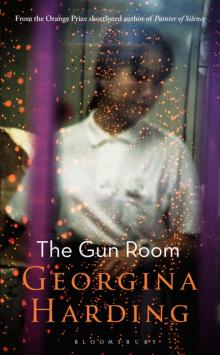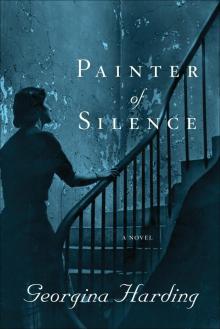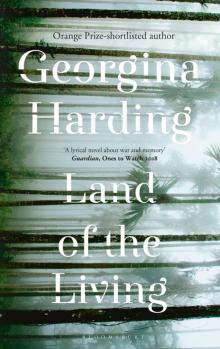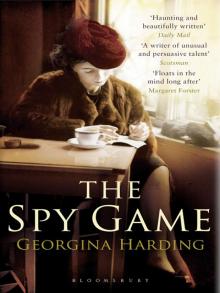- Home
- Georgina Harding
The Gun Room Page 2
The Gun Room Read online
Page 2
It was only much later, when he was out of the country and the pictures were developed, that he had the contact sheets before him and saw plainly what he taken, frame by frame.
When his thirty-day visa ran out he went to Hong Kong. He didn’t try to renew but got some commercial work there. He had a few introductions. He found a tiny room at the back of someone’s nice apartment on the Island with a slice of view down and across to Kowloon. The expat world was easy. It was easy, if you were British, to find work and an air-conditioned room and go out to eat exotically in the evening among the sampans in the harbour. He might have stayed much longer. But then he heard the name of the village in the news. It was named as the site of some atrocity.
He took the films for processing, and when the contacts were done he stayed in the shop to look at them. He asked for a magnifying glass and a china marker, took the glossy black-and-white sheets from their envelope and went through them then and there, where there was a lamp at a cramped table alongside the counter. He knew that it was best to do the job there, functionally, in that tight bare professional space where people shouted over his bent head in Chinese and did not know the meaning of what he did. He worked swiftly, because they were impatient with him in the shop but also because he could not allow himself thought. He would be professional as he had been at the time, when he had the lens between himself and what he saw. Alone before those images he would have been naked. He bent over the table and adjusted the lamp, moved the glass methodically along and down each sheet. One 35mm frame, one instant. And then the next. Beneath the glass the instants grew and massed one upon another. That was how they occurred, how it had been, but he tried not to think of that. He turned the sheets round, looked again. He concentrated on quality and composition. His work that day had been so confused that there were no more than a handful of shots that met technical requirements.
The pictures sold across the world. The one of the soldier made the cover of a magazine, staring out from the news-stands. He was out around the city the day that it was published. He saw the soldier staring out at the crowds who passed at the ferry pier, saw him rolled in a businessman’s hands. He saw him put down flat against a table in a bar and still he knew what was in those eyes. So he fled a second time. He didn’t call it flight, but only moving on. He told himself that he would pack up his camera and his few things and move on and learn to take different kinds of pictures, somewhere where there were different pictures to be taken. When the cheque came through it was enough to get away and set himself up in Japan.
2
Tokyo
In Tokyo the eyes are active. They see what is before them. People in Tokyo don’t look into themselves but out, and they don’t look into you either. That’s how it seems in his pictures. That’s what he had gone there for. He had gone to photograph Tokyo, capital city of dawning economic miracle. His photographs were intended to be modern, an exploration of modern Japan, of the transitional present. He would photograph Tokyo’s streets and Tokyo’s new buildings and Tokyo’s old buildings and Tokyo’s people. What people would do in his pictures, they would do for material reasons, because that was how he wanted to show the nature of this city, and the modern material world into which he wanted to show it was moving. When he photographs people walking through this city, he has all of them look like they are going somewhere, each one of them going somewhere, from one fixed point to another. They walk. They stop at pedestrian lights, at wide junctions where the broad white lines form a square and cross diagonally between. When the lights change, each figure or pair or group of figures takes its particular direction across the road or across the centre of the junction, and he photographs the figures from the slightest downwards angle so that they show as a pattern against the graphic floor of stripes. Sometimes the sun is shining and their shadows fall onto the stripes. Or if it is raining they hold umbrellas above their heads and the stripes become less significant.
They look at things. At their feet on the grey street on which they walk. At the traffic passing. At things in shop windows. At the dishes of plastic food displayed in the windows of restaurants. He photographs them looking, and he photographs the windows, the writing which he cannot read, the plastic food which makes it possible for a foreigner who cannot read a menu to make his choice. Then he looks up and photographs the billboards and the neon, the wires, the ugly ramshackle skyline, the impassive sky. All that is in his pictures when he first comes to Tokyo seems material, except the sky.
He had not expected the cold. Up until now Asia had been only heat to him. He must have known that Japan could be cold. He must at some time have seen pictures of Japan in the snow, photos, prints, Hiroshiges with flakes of snow falling, but the cold of Tokyo at the end of February caught him by surprise. Whatever snow there had been was long past. This was like the familiar chill of a day in English spring, though the air was drier, without the damp grey ache to it that came so often in March at home.
He had to buy warm clothes the morning after he arrived. He asked in the hotel where to shop and they sent him to a department store in Ginza, so that was the first place that he went to. There were pretty girls in uniforms and white gloves greeting customers at the door, and others like dolls in the lifts, but since he could not understand what they said or read the signs, he had to go up the escalators floor by floor to find what he wanted, the floors arranged much as in any department store – cosmetics, women’s formal clothes, women’s casual clothes, men’s clothes, household goods – and there he bought new clothes in which he felt unlike himself. Then he walked away with his bags along the streets, and had a neat Japanese haircut at a barber’s that he knew by the red barleysugar-striped pole outside. There were things here in Tokyo that you recognised, others that you didn’t, and what interested him, what he would have to try to take pictures of, was the gap between them, he thought, as he sat in the plush red chair, of a type that was familiar from such places everywhere, and watched in the mirror as the barber behind him took up the scissors, and didn’t know how to tell him what sort of cut he wanted.
When he came back to his hotel room at the end of the day he stood before the bathroom mirror, and put his hand through the Japanese haircut, and looked at himself. He took out his camera and focused it, held it beside himself and took a picture to record his arrival. He thought he looked blank in the mirror, like no one really, just a Westerner in Tokyo, neither recognisably American nor European, just a nondescript, slightly built young Caucasian male with new clothes and too-short brown hair holding a camera beside his head. But that was the way of so many self-portraits, he thought, that they were blank, unless the artist made an effort, put on a hat, cut off an ear and put a bandage round his head. There was a leather jacket that he had bought. It was the one extravagance of his shopping expedition, affordable because he was still flush with the payment from the magazine. He had taken it off when he had come into the heated room. He put it on again, and ruffled his hair some more and took his self-portrait again wearing the jacket. This was how he would appear to others, as someone strong, individual, whole. Then he put down the camera and looked closely at his reflection in the mirror. He looked into his own eyes, and that was all they were, eyes, grey eyes, looking at themselves, physical things, organs of sight. Cold eyes, they seemed to him, without spirit, material like everything else.
He took the jacket off again. He put on his new sweater over his new shirt, and then the jacket, and wrapped a scarf around his neck, this a rough-woven strip of green raw silk that he had bought on his travels, and went out in Roppongi. It was dark by now. This was a night-life district so everywhere he looked there were bars. He should have gone into one straight away, chosen the first that he saw. Failing to do that, he failed in the end to go into any at all. He walked past one after the other, looking at their signs. He walked until he was past them, all the garish lights behind him. He found side streets that were strangely quiet and small-scale, as if they had forgotten that they were in th
e centre of a city. He walked on, this way and that through the sleeping domestic streets, hungry by now and longing for a drink, but the bars and restaurants were gone. He was lucky to find a taxi. The seats had lacy covers and the driver wore white gloves like the girls in the department store and drove very smoothly. He had asked to go to the hotel as it was the only place with a name that he knew. He had taken so many twists and turns on his walk that he was surprised that it was so short a distance back along the main avenue. He ate some noodles then from a stall on a street corner, as he might have in South-East Asia only there the night would have been hot, and finally had a beer in the hotel bar. He dreamt that night that he was again in the village in Vietnam. He had had the dream a number of times before, but it had seemed to be fading. This time again it was vivid. There were colours to it: orange dust, and green, and red; red against black, black water, orange soil, stained with red. When he woke in the morning he believed for an instant that he had carried a gun instead of a camera.
All of that next day, he walked. He took pictures on the streets. He walked a long way from his hotel and went into a station somewhere and found himself on the Yamanote Line, which was an easy one for foreigners because it ran in a circle around the city. Even in the station he took pictures, of people waiting on his platform, then of people on the opposite platform lined up for the trains. As long as he stayed in Tokyo he would keep taking these pictures. There was something in them that drew him, the patterns the waiting figures made, the variety of them massed above the orderly horizontal of the railway line, the way particular individuals would stand out, in their dress or by what they were carrying or by their movement, the pragmatic look of people who were waiting, the waiting moments which were blanks, shared interstices in the individual action of each person’s day. The green carriages of the Yamanote ran above ground so there was daylight on the stations. When he took pictures in the moving train there was a moving skyline behind the passengers’ heads. He turned and took pictures through the thick glass of the window behind him. There were tall buildings within the circle of the Yamanote but outside of it the roofs mostly stretched low and interminably to the horizon. Later in his time in Tokyo when the sky was clear and the pollution was low he would photograph the conical snowcap on Fuji from one of those overground stations. He would not have believed it if he had been told that then, that the mountain could be seen from the city, because the city seemed so vast, complete in itself. He got off at Shinjuku. He went downstairs to find an exit and found that the station itself was another layer of city, a labyrinth underground. When at last he had found his way out, he stopped taking pictures and only walked. He walked on and filled his eyes with pictures. But it wasn’t enough. There are images that stay like stains on the memory. However you rub at them, however many other images you gather to replace them with, they don’t go. He walked on, following the crowd beneath the towering neon signs. He let himself merge into the crowd, carried along in its current. Though he was short for a man in England he was an ordinary height for a Japanese. He had the Japanese clothes. He had the notion that if he gave himself up to the crowd entirely, identity and memories might wash away.
The less he held to himself, the more he gave to the crowd, he thought, the more he would be a part of the place, understanding it in its present. The less he would have the past with him, the immediate past or any other past besides. That was what he had told himself he had come travelling for, to throw that ballast overboard – the past, that weighed him down. He had told no one where he was. He stood in the crowd at a crossing, waiting for the light to change, seeing the walk-light come up, hearing the birdsong that told the blind to walk, moving when the others moved, across the white lines in a wave. Before going to other places, until now, he had always sent home a poste restante address – except for Vietnam. Vietnam would have worried his mother, so he had not told her about Vietnam until afterwards. He might not have told her at all if it had not been for the pictures he sold, and the knowledge that she might come to see them and see his name beneath them. There had been postes restantes in Singapore, Jakarta, Denpasar, Bangkok, and then at last in Hong Kong, the best of them airy central post offices with fans suspended from high ceilings where he had queued behind a counter and given his name, received fat airmail envelopes with blue writing on them, numbered and folded pages in response to the brief notes he had written on postcards or on prepaid forms. Jonathan Ashe, poste restante: the simplest address. Now there was not even that.
Here he would have no name and no one would know him. He could walk a day through seething streets and see no one eye to eye. He went into a shop. The door slid open automatically, he did not have to touch it, and the shop assistant bowed, just so much that their eyes did not meet. There were greetings they spoke in the shops and in the restaurants, the same words everywhere, irrashaimasae…, when he entered and when he left. He did not know what the words meant. He went to a restaurant, and the door slid open untouched, and the words were the same. If they had not said those words at him then he might have had the feeling that he did not exist.
After all, it was being seen that made a person real. He had the sense, when he took pictures and the pictures were developed, that by seeing things and photographing them he was bringing them into existence, fixing some part of their nature that only he had seen. He went back to his hotel room, one small room of so many down a silently carpeted corridor. There again he took a picture of himself. He set the camera up on the table, self-timed a portrait of himself in jeans and grey T-shirt seated on the ruckled sheet with piled white pillows and the bare wall behind him. He took pictures of the room with his few things spread about in the attempt to inhabit it: his jacket on a hanger hung outside not within the wardrobe door, spread papers and camera case on the table. He had bought the English-language newspaper for the ads in it. He could not afford the hotel for long. He laid the paper out on the bed and looked them through.
The apartment he found was out of the centre of the city, down a suburban line that he had not yet travelled. He made his way there according to the directions he was given, turning away from the brash little streets of the entertainment district around the station and going down through a park. Two rooms to sublet from a Canadian Buddhist called Laura while she went to follow a guru in India.
There’s a good energy here, Laura said. She spoke so earnestly he had to believe her. There was light. Light, she said, was so important to the Japanese. The two upstairs rooms faced south, each one six mats in floor area, and the value of the rental was based on the aspect and the mat size.
Laura was a pale girl with long blonde hair. She pushed back the windows to show him the view, neat little gardens of evergreens and the backs of houses all irregularly arranged so that no single one seemed to face onto or overlook another. She waved a pale hand at them. Privacy also, she said, was important to the Japanese. Each house had its small unique space, as each person did. She hoped that he wouldn’t make much noise? They were careful about noise here. If a person played the saxophone for example, then he might take it and practise in the park. There was someone who did that, who you saw every day at the same time, playing beneath a tree. He didn’t play the sax, did he?
Oh, I’m very quiet, Jonathan said.
The girl pushed back the paper doors on the cupboards and showed him where the bedding was kept. Put it down each night and take it up in the morning. Then these rooms seem quite big enough. In the West we have to have our houses so big because we have too many things, don’t you think? The Japanese understand how to live without things, with only light and space.
Yes, he said, though he had been seeing the Japanese quite otherwise, but he loved the idea of this apartment. There was a tiny kitchen with two gas rings to cook from and a small window looking onto the narrow residential street, and an even smaller bathroom to bathe in Japanese-style, where he would squat to wash first and then take a very hot dip in the deep plastic bath.
You fill
it cold and put it on for thirty minutes to heat the water, she told him. But careful, don’t boil the bathtub.
I’d like to take the flat, he said. When do you come back from India?
She pushed some vague blonde hair back behind her ear. I’m not sure, she said. It’s hard to keep track once you get to the ashram. Let’s say three months for now. Is that OK, three months? Or maybe six? That would take us through till September, September’s beautiful here. But I’ll send you a card before then. I’ll send you a card and say how it’s going.
Then she took him to meet the landlady who lived downstairs, a tiny old woman in a grey kimono. Laura went into the hallway and spoke to her in Japanese while he hovered at the threshold unsure whether to take off his shoes and enter.

 Harvest
Harvest The Gun Room
The Gun Room Painter of Silence
Painter of Silence Land of the Living
Land of the Living The Spy Game
The Spy Game The Solitude of Thomas Cave
The Solitude of Thomas Cave